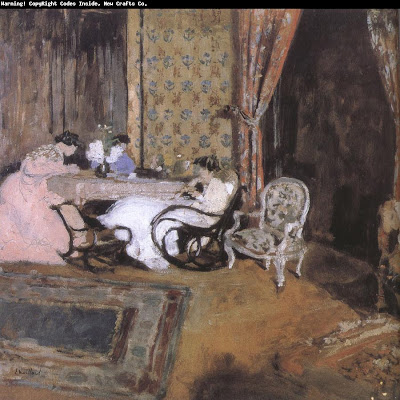Intimate Interiors: What we learn from Vuillard
On Friday I was speaking with a student in my Painting class at MICA and told her I saw similarities in her work to that of Vuillard's. She hadn't heard of Vuillard, nor had two other students I'd mentioned his work to in the previous week. So I thought it would be fun to summon up some of the old guy's paintings. They're really lovely sometimes.
Edouard Vuillard was a French painter (1868-1940) who inhabited those fertile waters in that country between the advent of impressionism in mid century and the plunge into full blown abstraction of the early days of the 20th century. Vuillard did lots of different kinds of work, going from these adventurous pattern oriented oils to timid commercial portraiture that almost nobody looks at these days (he had to pay the rent too). But at his best, like the ones I've chosen here, he's a delight.
In the above painting, two bentwood rocking chairs are placed facing each. Vuillard loved their pretzel-like curves. So to make those the focal points of the painting, he poses a flowing white dress behind their dark curving lines to spotlight them. The dress is carefully shaped to include not only similar curves but also a sharp vertical edge falling straight downwards. This vertical line is intentional and critical to "anchor" all the swirling shapes in the dress and chairs.
Vuillard more than any artist I can think of used the shapes of fabrics to define his figures. Certainly in the painting above. And below is one I love but I'm only fairly confident it has a figure in it, though it does seem a cat or dog makes an appearance. What he's showing us is that there are lots of ways to install human personality into a painting.
Vuillard is famous for exploiting decorative patterned fabric. Below is a fabulous example with the standing woman's dress dominating the painting.
He's is careful though to not over do it with the heavy patterning. The standing figure for instance is also a carefully posed silhouette, and her dress gradates beautifully from lights near her neck to a midtone shadow as we desccnd to her knees. Her dominant pattern is contrasted purposefully against empty flat surfaces.
I think Vuillard is a master at creating abstract rhythms to move your eyes through his entire composition. In the above oil, squint your eyes and focus on the chain of irregular black shapes that skip across the painting's surface. Part of his success is his willingness to put in almost too many forms to crowd his spaces. Then he adjusts and edits his way to a composition that's tied together like a seamen's knot.
Landscape painting might at first glance seem unrelated to Vuillard's interiors, but actually they're close cousins. Vuillard created what might be called "interior jungles" with his heavily decorated rooms. Anyone who's looked at the overwhelming complexity of a forest interior like those painted by a Barbizon School artist or an American like Worthington Witteredge has sensed this affinity.
We find ourselves drawn to paintings like Vuillard's because they remind us the possibility of making a powerful, unified world is real. As humans, that's terrribly good news. And for artists, Vuillard remains one of the great teachers about how to do it.





